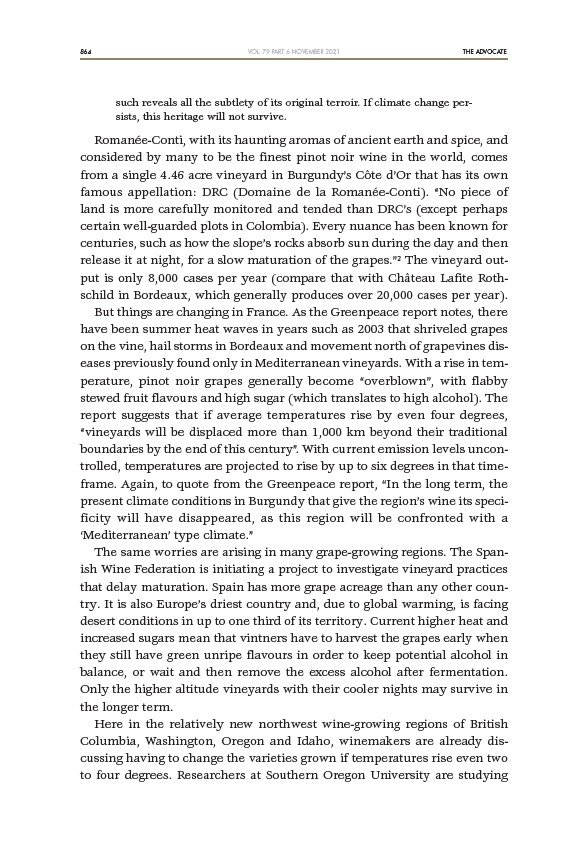
864 THE ADVOCATE
VOL. 79 PART 6 NOVEMBER 2021
such reveals all the subtlety of its original terroir. If climate change persists,
this heritage will not survive.
Romanée-Conti, with its haunting aromas of ancient earth and spice, and
considered by many to be the finest pinot noir wine in the world, comes
from a single 4.46 acre vineyard in Burgundy’s Côte d’Or that has its own
famous appellation: DRC (Domaine de la Romanée-Conti). “No piece of
land is more carefully monitored and tended than DRC’s (except perhaps
certain well-guarded plots in Colombia). Every nuance has been known for
centuries, such as how the slope’s rocks absorb sun during the day and then
release it at night, for a slow maturation of the grapes.”2 The vineyard output
is only 8,000 cases per year (compare that with Château Lafite Rothschild
in Bordeaux, which generally produces over 20,000 cases per year).
But things are changing in France. As the Greenpeace report notes, there
have been summer heat waves in years such as 2003 that shriveled grapes
on the vine, hail storms in Bordeaux and movement north of grapevines diseases
previously found only in Mediterranean vineyards. With a rise in temperature,
pinot noir grapes generally become “overblown”, with flabby
stewed fruit flavours and high sugar (which translates to high alcohol). The
report suggests that if average temperatures rise by even four degrees,
“vineyards will be displaced more than 1,000 km beyond their traditional
boundaries by the end of this century”. With current emission levels uncontrolled,
temperatures are projected to rise by up to six degrees in that timeframe.
Again, to quote from the Greenpeace report, “In the long term, the
present climate conditions in Burgundy that give the region’s wine its specificity
will have disappeared, as this region will be confronted with a
‘Mediterranean’ type climate.”
The same worries are arising in many grape-growing regions. The Spanish
Wine Federation is initiating a project to investigate vineyard practices
that delay maturation. Spain has more grape acreage than any other country.
It is also Europe’s driest country and, due to global warming, is facing
desert conditions in up to one third of its territory. Current higher heat and
increased sugars mean that vintners have to harvest the grapes early when
they still have green unripe flavours in order to keep potential alcohol in
balance, or wait and then remove the excess alcohol after fermentation.
Only the higher altitude vineyards with their cooler nights may survive in
the longer term.
Here in the relatively new northwest wine-growing regions of British
Columbia, Washington, Oregon and Idaho, winemakers are already discussing
having to change the varieties grown if temperatures rise even two
to four degrees. Researchers at Southern Oregon University are studying